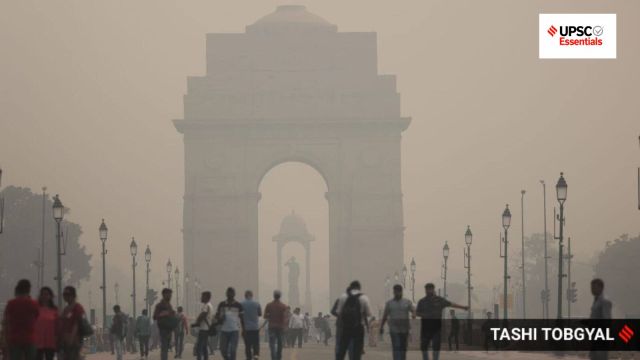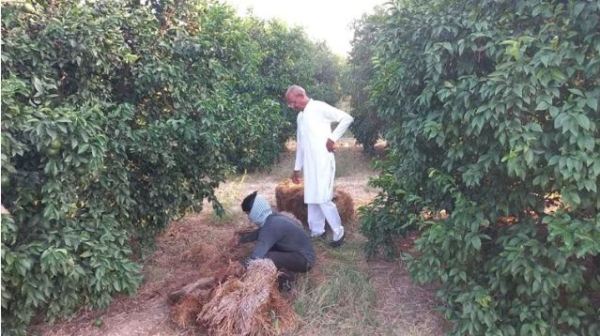Subject: Environment, Pollution
WHY IN NEWS?
— For the first time this season, Delhi’s air quality plummeted to hit the ‘severe’ category on Thursday.
— Factors like low wind speed and intrusion of smoke from stubble burning — added to the impact of local emissions.
— This resulted in the air quality consistently worsening through the day from an average of 351 at 10 am to touch 402 at 5 pm. By 9 pm, it had deteriorated further to 418.
KEY TAKEAWAYS
WHAT IS AQI?
— AQI is a number, which is a measure of air quality. The higher the AQI, the worse the air.
— There are six categories of AQI, namely ‘Good’ (0-50), ‘Satisfactory’ (50-100), ‘Moderately polluted’ (100-200), ‘Poor’ (200-300), ‘Very Poor’ (300-400), and ‘Severe’ (400-500).
Story continues below this ad
— According to the Central Pollution Control Board, part of the Ministry of Environment, Forests and Climate Change, the AQI transforms complex air quality data of various pollutants into a single number (index value), nomenclature and colour. The pollutants measured include PM 10, PM 2.5, NO2, SO2, CO, O3, NH3, and Pb.
— For a general understanding it is considered as ‘One Number- One Colour-One Description’ to know the air quality in a particular area.
WHO LAUNCHED IT AND WHEN?
— It was launched by the central government in 2014 as part of the Swachh Bharat campaign.
— An expert group comprising medical professionals, air quality experts, academia, advocacy groups, and others was constituted and a technical study was awarded to IIT Kanpur. IIT Kanpur and the Expert Group recommended an AQI scheme.
Story continues below this ad
JUST FYI
— There is a calculation that goes behind the index. There are six or eight pollutants in the affected air and each of these pollutants is given a weight based on a formula.
— That weight depends on the kind of impact it has on human health. The worst of these weights is given as composite air quality, so instead of giving you six different numbers, and six different colours, it throws up one single colour, one single number to denote the overall impact. Monitoring stations across the country assess these levels.
— Among the more harmful pollutants are those of a smaller size, such as particulate matter (PM) 2.5, which is an atmospheric particulate matter of diameter smaller than 2.5 micrometres (or around 3 per cent of the diameter of a human hair). It causes respiratory problems and reduces visibility. The particles can only be detected with the help of an electron microscope because they are so small.
— Due to their size, the PM 2.5 particles can easily bypass the nose and throat and can easily enter the circulatory system. The particles can also lead to cause chronic diseases such as asthma, heart attack, bronchitis and other respiratory problems.
WHY IS IT RELEVANT?
Story continues below this ad
— Simply as it helps the public and the government understand the condition of the air and what subsequent measures are to be taken to combat the situation, based on its severity.
Beyond the term
CASE STUDY: This technique used by a Punjab farmer helps stop stubble burning, reduces water requirement by Raakhi Jagga
Relevance: The contribution of stubble burning to PM2.5 levels in Delhi hit the highest figure for the season so far on Thursday, standing at 25.232%, as per the Decision Support System (DSS) developed by the Indian Institute of Tropical Meteorology. Let’s learn through this case study, what an individual can do.
While the movement against stubble burning gained momentum only in the last five to six years, 67-year-old Omparkash Bhambu, a farmer in Punjab’s Fazilka district, has been using stubble to do mulching at his kinnow orchard since 2011.
Story continues below this ad
Surprisingly, the method not only helps in lessening the ill effects of stubble burning, it also leads to a fifty per cent reduction in the requirement of water by the plants.
Mulching is a technique to use decaying leaves, stubble or barks to cover the ground or a plant in order to enrich the soil and at the same time, insulate it from high temperatures.
Bhambu, who has his farm in the Ramkot village of Balluana constituency, said, “In 2011, I tried mulching around 50 kinnow trees with paddy straw. I found out that these trees required 50 per cent less water in comparison to those where I did not mulch the soil.”
 Bhambu has 40 acre of land and he grows kinnows on 20 acre. On 5 acre of land, he grows cotton and has dedicated 4 acre to paddy. (Express photo)
Bhambu has 40 acre of land and he grows kinnows on 20 acre. On 5 acre of land, he grows cotton and has dedicated 4 acre to paddy. (Express photo)
He added, “I grow kinnow on 20 acre of land and after the first year’s success, from 2012, onwards I started mulching my entire orchard. Eleven years have passed and I still mulch by collecting paddy stubble from 16 acre of land. While I grow paddy on four acre of land, for the stubble, I approach farmers from the adjoining village of Kabul Shah Khubban.”
Explaining the cost of mulching, Bhambu said, “Farmers give it away for free of cost but I have to spend Rs 4,000 for cutting the stubble by hiring labourers, transporting it to my farm and as storage expenses.”
The inspiration
Story continues below this ad
It was in 2011 when Bhambu learnt the method of mulching while watching a television report. “Some farmers of Maharashtra had done mulching at their grapevine with grass in order to reduce the requirement of water since the state was hit by drought.”
Reducing stubble burning
Bhambu’s procurement of stubble from the adjoining village has reduced stubble burning at the Kabul Shah Khubban village, albeit marginally. Sandeep Kumar, a farmer whose paddy stubble Bhambu has been procuring for the last seven years, said, “I am happy that he takes away the stubble as in this way, I am not engaging in stubble burning. By taking away the paddy stubble he also readies my field for wheat harvest.”
Bhambu said last year he earned around Rs 24 lakh after excluding all expenses.
“I feel proud that I am helping in conserving the environment by not burning stubble, guiding others not to burn and even by saving water,” Bhambu said.
Story continues below this ad
Point to ponder
What is the Graded Response Action Plan or GRAP?
GRAP is a set of emergency measures that kick in to prevent further deterioration of air quality once it reaches a certain threshold in the Delhi-NCR region. Approved by the Supreme Court in 2016 and notified in 2017, the plan was formulated after several meetings that the Environment Pollution (Prevention and Control) Authority (EPCA) held with state government representatives and experts. The result was a plan that institutionalised measures to be taken when air quality deteriorates.
GRAP is incremental in nature and thus, when the air quality dips from ‘poor’ to ‘very poor,’ measures listed under both sections have to be followed. Stage 1 of GRAP is activated when the AQI is in the ‘poor’ category (201 to 300), Stage 2 is when it’s in the ‘Very poor’ category (301-400), Stage 3 is when the AQI is the ‘Severe’ category (401-450) and finally Stage 4 is when it rises to the ‘Severe +’ category (more than 450).
Post Read MCQ:
Which of the statements below is not true with reference to AQI?
Story continues below this ad
(a) It was launched by the central government in 2014 as part of the Swachh Bharat campaign.
(b) It transforms complex air quality data of various pollutants into a single number (index value), nomenclature and colour.
(c) When AQI is in the ‘very poor’ category Stage 1 of GRAP is activated.
(d) There are six categories of AQI.
Post your answer in the comment box below.
Share your views and suggestions in the comment box or at manas.srivastava@indianexpress.com



 Bhambu has 40 acre of land and he grows kinnows on 20 acre. On 5 acre of land, he grows cotton and has dedicated 4 acre to paddy. (Express photo)
Bhambu has 40 acre of land and he grows kinnows on 20 acre. On 5 acre of land, he grows cotton and has dedicated 4 acre to paddy. (Express photo)






























